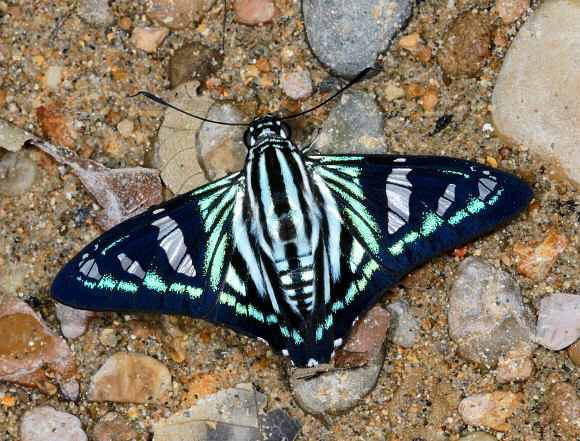
Introduction
The subfamily Pyrginae are characterised by their habit of basking with wings outspread, compared to the half-open position favoured by the Hesperiinae.
The tribe Eudamini includes 44 genera in the Americas, amongst which are the Long-tailed Skippers Urbanus, Chioides and Aguna; and other familiar genera including Phocides, Autochton, Astraptes and Calaenorrhinus.
Phocides bear a remarkable resemblance to their distant cousins Jemadia, Tarsoctenus and Elbella, all of which are placed in a different subfamily, the Pyrrhopyginae. This suggests that they may all be involved in a mimicry complex as it is difficult to understand why two very similar patterns could otherwise have evolved. Most Pyrrhopyginae exhibit aposematic colouration, implying that they are generally unpalateable or toxic to birds. It seems likely that Phocides are Batesian mimics and that Jemadia, Tarsoctenus and Elbella are Mullerian mimics.
The easiest way to distinguish Phocides from the other genera is to examine the metallic turquoise-white stripes in the basal area of the forewings. These radiate from the base in Phocides but are vertical in the Pyrrhopygine genera.
There are 18 Phocides species, distributed variously from Texas and Florida to Bolivia, Paraguay and Argentina.
Phocides pigmalion is an extremely variable species which is distributed from Florida to Brazil and Peru, and also occurs in the Caribbean on Cuba, Hispaniola and the Bahamas. The northern races okeechobee, batabano and batabanoides are known locally as Mangrove Skippers. They are very dark, without hyaline areas. The markings are limited to just a series of vague turquoise stripes on the hindwings. The southern races pigmalion and hewitsonius are strikingly marked, and similar in pattern to metrodorus except that the hyaline area in the fw discal cell is strongly notched.
The illustrated subspecies Phocides pigmalion hewitsonius is found in lowland areas of eastern Peru, and in s.w. Brazil.
Habitats
This species is found in tropical and subtropical forest at altitudes between 0-600m.
Lifecycle
The eggs are reportedly laid singly on the upperside of leaves of the foodplants. Phocides species are known to feed on Psidium and Eugenia ( Myrtaceae ). They are nocturnal feeders, and rest by day in nests constructed from silk and folded leaves.
Adult behaviour
The butterflies are normally found as solitary males imbibing mineralised water from wet ground at the edge of small streams. They are usually very easy to approach.
